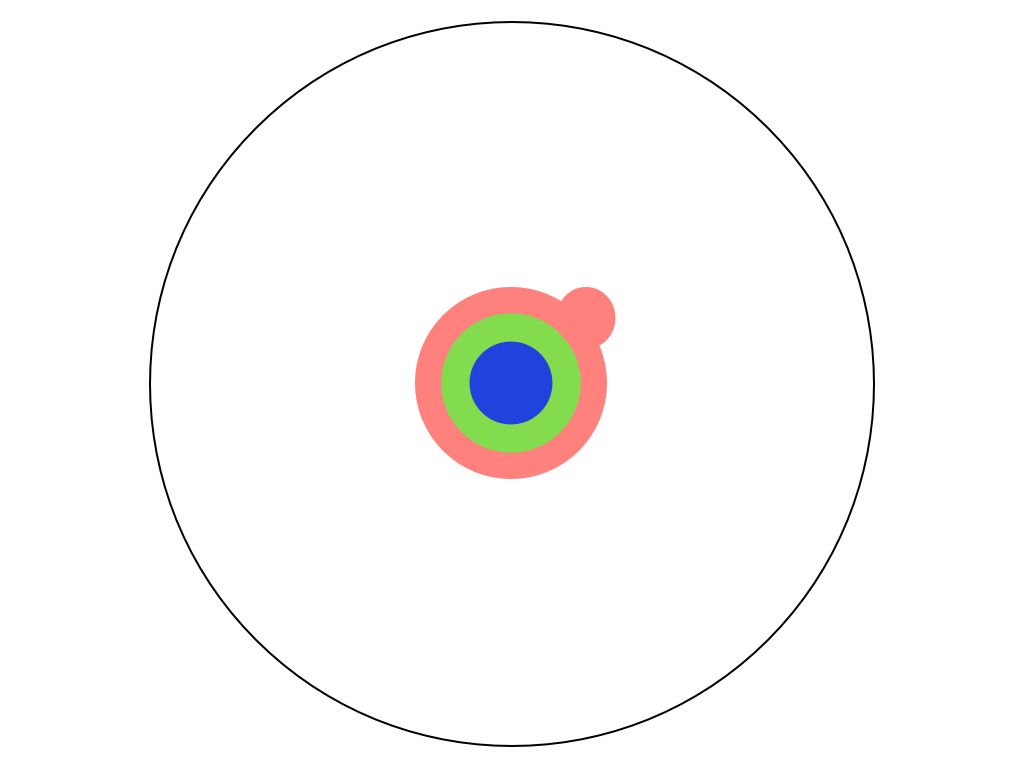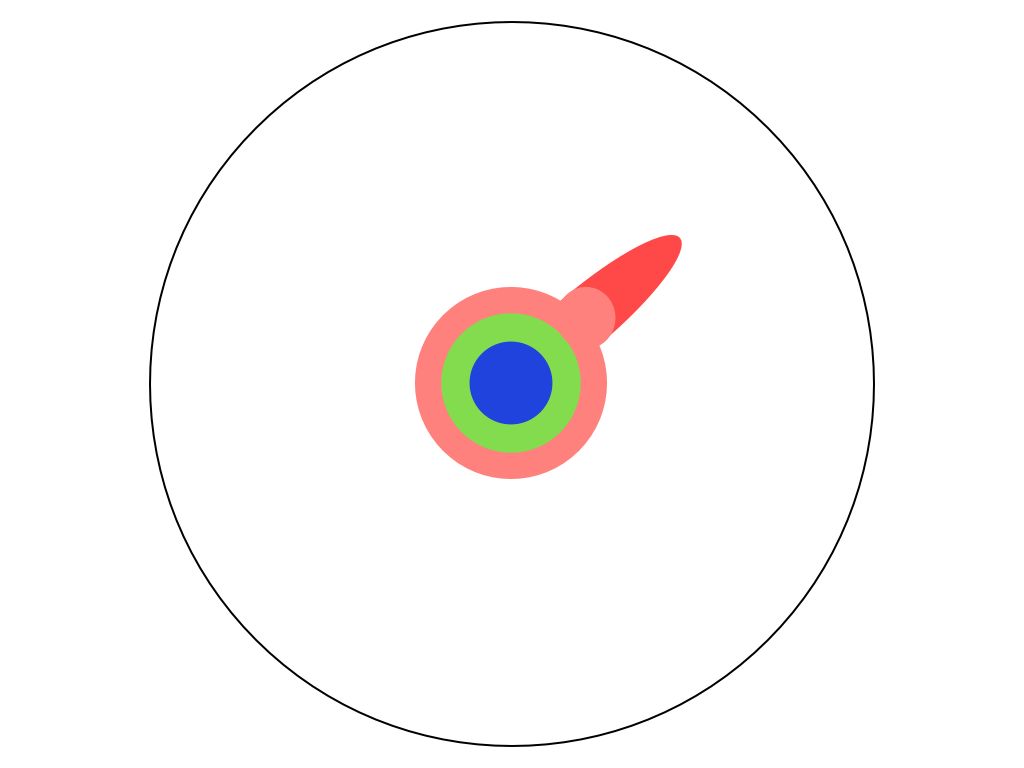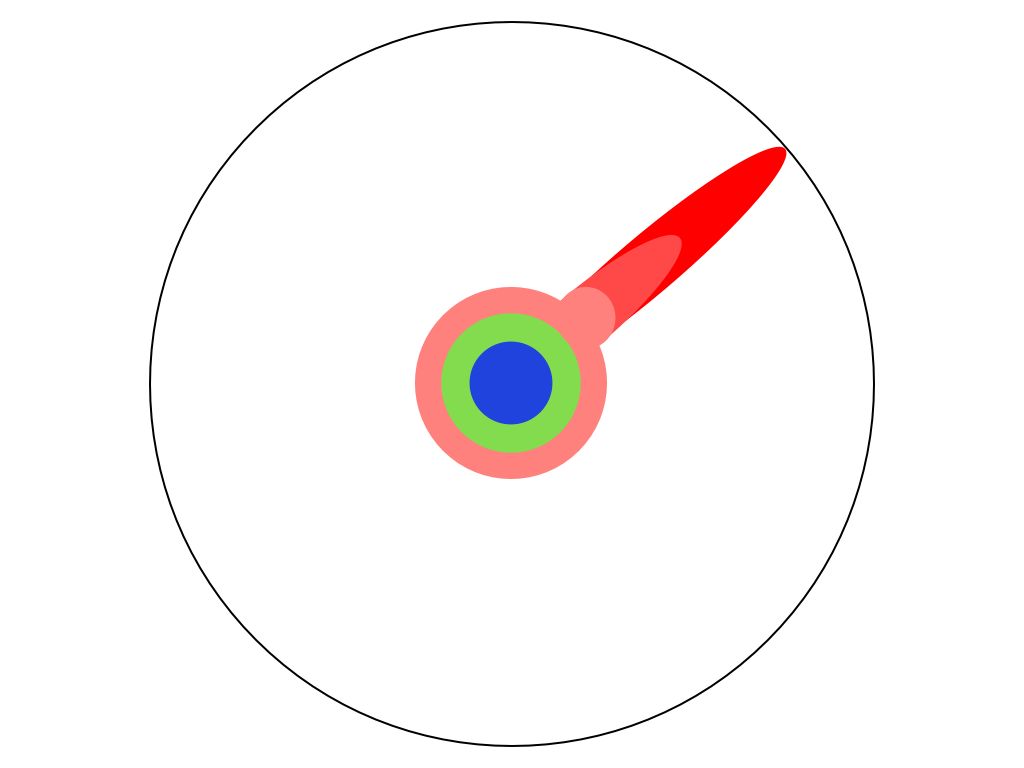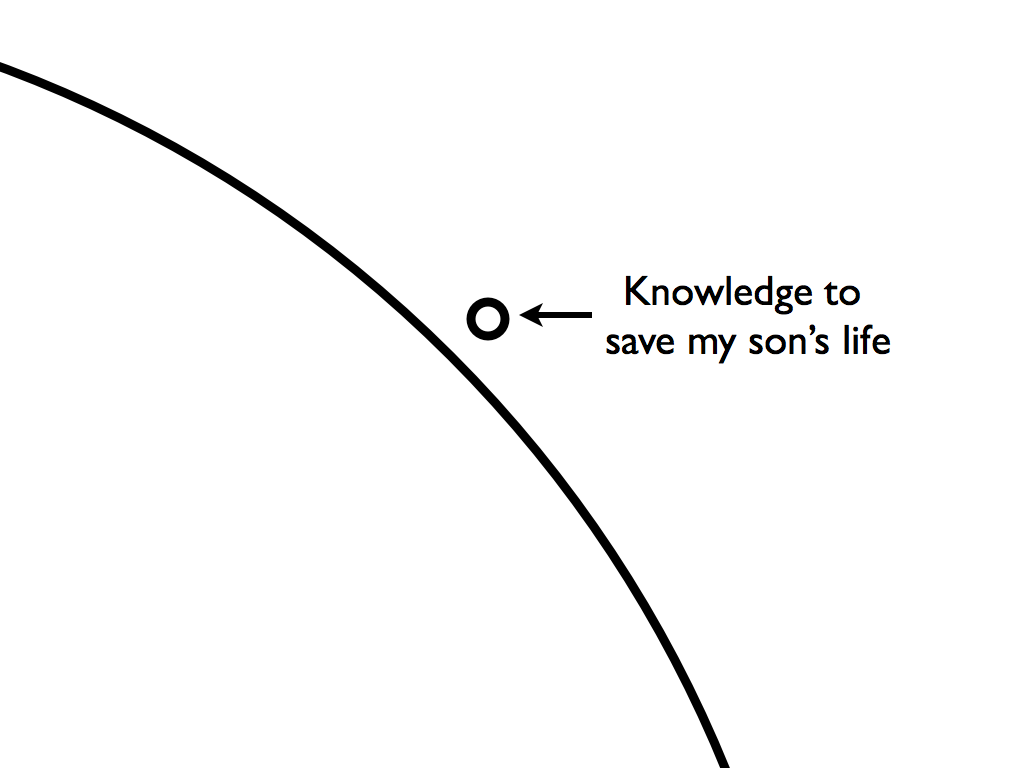출처 : http://www.ddanzi.com/free/188747995
http://matt.might.net/articles/phd-school-in-pictures/
The illustrated guide to a Ph.D.
Every fall, I explain to a fresh batch of Ph.D. students what a Ph.D. is.
It's hard to describe it in words.
So, I use pictures.
Read below for the illustrated guide to a Ph.D.
Update: Print version, slides and translations, CC licensing terms.
Update: I wrote a follow-up to this 5 years later -- HOWTO: Get tenure.Imagine a circle that contains all of human knowledge:

By the time you finish elementary school, you know a little:

By the time you finish high school, you know a bit more:

With a bachelor's degree, you gain a specialty:

A master's degree deepens that specialty:

Reading research papers takes you to the edge of human knowledge:

Once you're at the boundary, you focus:

You push at the boundary for a few years:

Until one day, the boundary gives way:

And, that dent you've made is called a Ph.D.:

Of course, the world looks different to you now:

So, don't forget the bigger picture:

Keep pushing.
There's a bit more below, but I also wrote a follow-up 5 years after the illustrated guide which may be of interest -- HOWTO: Get tenure.
Related posts
- HOWTO: Get tenure.
- Recommended reading for grad students.
- What every CS major should know.
- How to get into grad school.
- Advice for thesis proposals.
- Productivity tips for academics.
- Academic job hunt advice.
- Successful Ph.D. students: Perseverance, tenacity and cogency.
- The CRAPL: An open source license for academics.
- The shape of your problem.
If you like these posts, then I recommend the book A PhD Is Not Enough:
Get it in print; fund students; save lives
By request, a print version of The Illustrated Guide to a Ph.D. is on sale.
Any and all proceeds will fund graduate students whose work may impact the discovery, diagnosis or treatment of genetic disorders.
Any and all proceeds will fund graduate students (and postdocs) doing work in biology that may impact treatment of diseases of cellular metabolism.
Update: If you're interested in being that postdoc, get in touch with me!
It is available at $6.50 thanks to Hewlett-Packard's high-quality on-demand publishing service, MagCloud.
It's sixteen pages, saddle-stitch bound and in full color.
It's a good gift for new students, the recently defended and relatives thereof.
Why biology?
If you zoom in on the boundary of human knowledge in the direction of genetics, there's something just outside humanity's reach:

My wife and I chose to start funding these graduate students after we learned that our son has a rare, fatal genetic disorder.
It may be too late for my son, but it's not too late for other children.
Even one child suffering is one child too many.
The only way to end this kind of suffering is science.
And, the best way to do science is through graduate students.
Update: When I first wrote this post, my son's specific disorder was unknown. Thanks to a scientific advance made in genetic diagnostics--specifically exome sequencing--we were able to isolate the mutations in my son's genome and determine that he is the very first documented case of a new disease: N-glycanase deficiency.
One small dent in the circle of knowledge; one giant leap for my son.
You can read the full story in a new post: Hunting down my son's killer.
License: Creative Commons
I receive numerous requests to reproduce this work, and I'm happy to grant them all, subject to three small conditions:
- Please attribute the original work to me (Matt Might) and link back to this page in your reproduction:
http://matt.might.net/articles/phd-school-in-pictures/asThe Illustrated Guide to a Ph.D. - When you attribute, please also link my name,
Matt Might, to:http://matt.might.net/ - And, don't forget the "Keep pushing," at the bottom!
This work is licensed under the Creative Commons Attribution-NonCommercial 2.5 License.
That means you can share, copy, modify and reproduce this work as long as you attribute the original work to me and link back to it as outlined above.
However, you may not sell this work, or use it for commercial purposes. You may only distribute it free of charge. If you're not sure whether your use is a "commercial purpose," please send me an email.
If possible, please host the images on your own server instead of linking back to mine.
If you use it in a presentation, I'd love to hear feedback.
Here's an example attribution that satisfies the legal requirements:
Matt Might, a professor in Computer Science at the University of Utah, created The Illustrated Guide to a Ph.D. to explain what a Ph.D. is to new and aspiring graduate students. [Matt has licensed the guide for sharing with special terms under the Creative Commons license.]
If it helps, here's the corresponding HTML, which you can modify to suit your site's needs:
<a href="http://matt.might.net/">Matt Might</a>, a professor in
<a href="http://www.cs.utah.edu/">Computer Science</a>
at the <a href="http://www.utah.edu/">University of Utah</a>, created
<a href="http://matt.might.net/articles/phd-school-in-pictures/">The
Illustrated Guide to a Ph.D.</a> to explain what a Ph.D. is to new and
aspiring graduate students.
[Matt has licensed the guide for sharing with
<a href="http://matt.might.net/articles/phd-school-in-pictures/#license">
special terms under the Creative Commons license</a>.]
And, of course, thank you for sharing!
Resources
Please let me know if you translate this post into another language.
- A slideshow version in PDF.
- French translation (by Sara Mathieu-C.)
- Urdu translation (by Adnan Masood)
- Japanese translation (by Kimikazu Kato)
- UK English "translation" (as interpreted by Gabriel Egan)
- Brazilian Portuguese translation (by Kleber Jacinto)
- Turkish translation (by Y.Ercan Payidar)
- Spanish translation (by Ismael Peña-López)
- Italian translation (by Alessandro Ferrari)
- Indonesian translation (by Robin Malau)
- Greek translation (by Anestis Chatzidiakos)
- Korean translation
- Norwegian translation (by DION)
- Russian translation (by Shemra Rizzo)
- Hungarian translation (by Zoltan Prekopcsak)
- Chinese translation (by Yifeng Yuan)
- Simplified Chinese translation by (Sijia Zhao)
- German translation (by Paul Balzer)
- Persian translation (by Kian Abbasnejadi)
- Czech translation (by Lukas Kalous)
- Slovak translation (by Stano Bustor)
- Serbian Translation (by Lazar Kovacevic)
- Swedish Translation
- Filipino translation (by Andrew Pua)
- Italian translation (by Marco Fotino)
- Arabic translation (by Areeb Alowisheq)
- Vietnamese translation.
- Polish translation.
- Dutch translation.
- Ukranian translation.
- Hebrew translation (by Regev Elya).
- Belarussian translation.
- Catalan translation by Sebas Mas.
- Finnish translation by Joutsiniemi Anssi.
- Basque Translation by Jesus Romo.
공부하기 위해 학교에 가서 학위를 가지고 간다. 학위의 최고봉 박사 (Ph. D.) 이란 도대체 어떤 것인가?
유타 대학에서 컴퓨터 과학을 가르치는 Matt Might 교수가 일러스트를 통해 알기 쉽게 해설. 매년 초에 박사 학위를 취득하려는 학생들이 이야기를한다고합니다.
이 원형 안에 사람의 지식의 모든 수 있습니다
초등학교 졸업 정도는이 정도의 지식이.
고등학교 졸업 정도는
4 년제 대학 졸업하고 학사가 되면
대학원에서 더욱 그 전문 분야를 깊게합니다.

연구 논문을 땅땅 부르고 있기에 인간의 지식의 테두리로 접근합니다.
자신의 전문 분야를 올리실 지식의 테두리로 도달합니다.
그리고 그 테두리를 몇 년 동안 누르고 있습니다.
그리고 마침내 ... 밀려 계속해서 테두리가 움푹 난간 있습니다!
그 움푹 한 돌출 부분 이야말로 박사입니다.
하지만 큰 그림을 잊어서는 안됩니다.

출처: http://www.gizmodo.jp/2010/08/post_7507.html
구글번역이라 내용이 어색한점 양해 바랍니다.
학사: 여러분이 대학의 파리학과를 졸업하고 입사한 파리학사라고 가정해보자.
파리학사는 파리개론부터 배우기 시작해서 파리 앞다리론, 파리 뒷다리론, 파리 몸통론 등
파리 각론을 배우고 졸업하기 이전에 파리를 분해조립하고
파리가 있는 현장에 가서 인턴십 등 실습을 한 다음
파리학사 자격증을 취득하면 “이제 파리에 대해서 모든 것을 알 것 같다”고 말한다.
석사: 파리에 대해서 전문지식이 부족한 파리학사는 파리학과 대학원 석사과정에 입학한다.
파리석사는 파리 전체를 연구하면 절대로 졸업할 수 없기 때문에
파리의 특정 부위, 예를 들면 ‘파리 뒷다리’를 전공한다.
파리 뒷다리를 전공하는 파리학과 대학원생은 파리 뒷다리를 몸통에서 분리한 다음
실험실에서 2년간 연구한 다음 ‘파리 뒷다리가
파리 몸통에 미치는 영향에 관한 연구’라는 논문으로 파리 석사학위를 받는다.
파리석사는 이제 무엇을 모르는지 알 것 같다고 한다.
파리 뒷다리 전공자에게 절대로 파리 앞다리를 물어봐서는 안 된다.
파리 뒷다리 전공자는 파리 앞다리에 대해서는 아는 바가 없기 때문이다.
파리 석사는 파리에 관한 보다 세분화된 전공지식을 습득하기 위해 파리학과 대학원 박사과정에 입학한다.
박사: 파리학과 박사과정생은 파리 뒷다리를 통째로 전공해서는
절대로 박사학위를 취득할 수 없는 현실을 너무도 잘 알고 있기 때문에 ‘파리 뒷다리 발톱’을 전공한다.
박사학위 논문을 쓰기 전에 파리학과 대학원 박사과정생은 전국추계 파리발톱 학술대회에 나가서
그 동안 연구한 파리 발톱의 특정 부위 성분이 파리 발톱 성장에 미치는 영향에 관한 연구라는 부논문을 발표한다.
이런 부논문을 더욱 세분화시켜 1년생 파리 뒷다리 발톱의 성장패턴이
파리 먹이 취득 방식에 미치는 영향에 관한 연구로 박사학위를 취득한다.
파리 박사학위는 “나만 모르는지 알았더니 남들도 다 모르는 군” 이런 깨달음이 오면 주어지는 학위다.
여기서 중요한 점은 파리 발톱을 전공한 박사전공자간에도
발톱 부위별 전공부위가 달라서 커뮤니케이션이 쉽게 일어나기 어렵다는 점이다.
교수: 이제 파리학과 교수는 보다 세분화된 전공을 선택해야 교수사회로 입문할 수 있다.
교수가 전공하는 파리 부위는 ‘파리 발톱에 낀 때’다.
파리 발톱에 낀 때를 전공하는 교수들도 까만 때를 전공하는 교수,
누리꾸리한 때를 전공하는 교수, 30년산 때나 21년산 때를 전공하는 교수,
18년산이나 15년산 또는 12년산 때를 전공하는 교수로 나뉘어서 동일한 파리의 때를 전공하지만
전공영역이 달라서 때를 전공하는 교수들끼리도 사용하는 전공용어상의 차이로 인하여
커뮤니케이션이 쉽게 일어나지 않는다.
이렇게 교수가 되면 “어차피 모르는 것, 끝까지 우겨야 되겠다”라는 말을 하게 된다.
파리는 파리 전체를 이해한 다음 각론으로 들어가서 이해할 필요가 있다.
파리 특정 부위가 파리 몸통 전체와 어떤 구조적 연관성을 갖고 있는지에 대한 지식 없이 파리를 이해할 수 없다.
출저- 유영만 교수(지식생태학자 한양대 교육공학과)의 파리학과 출신들의 지식경영 추진 방법중에서













